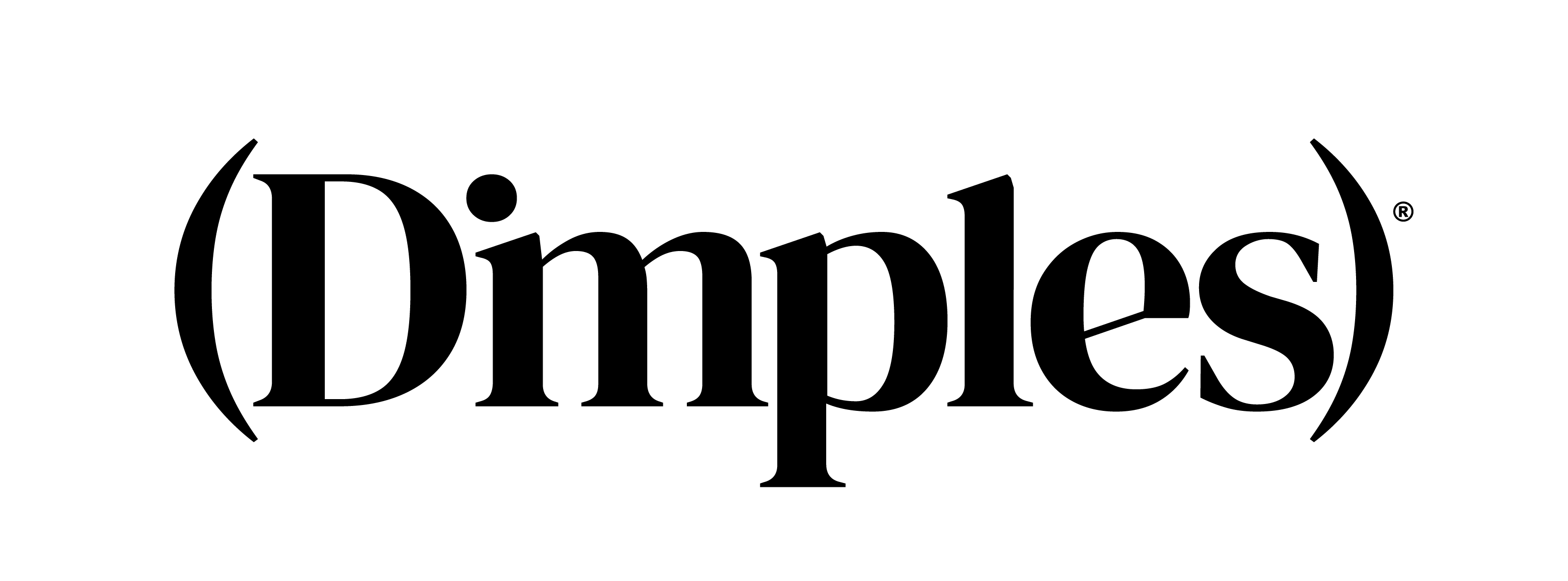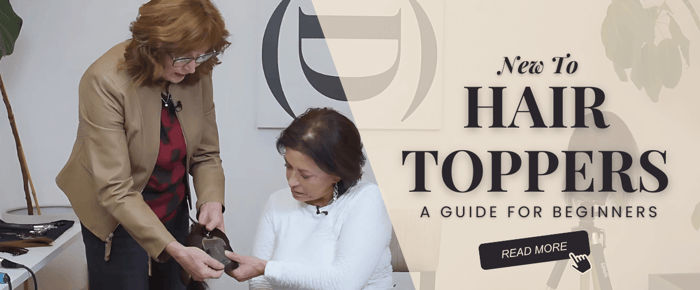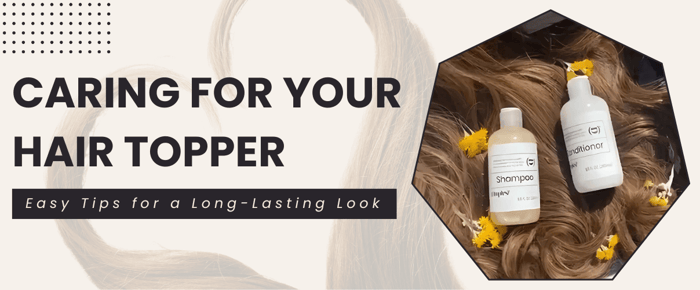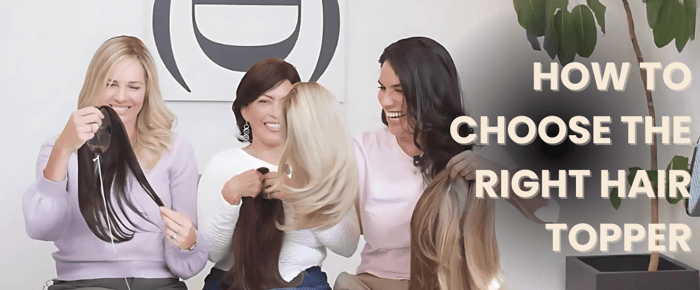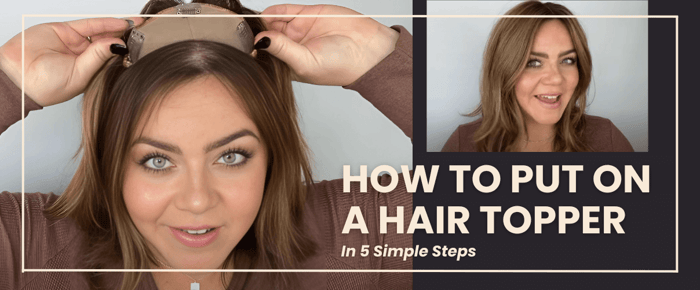Hair toppers are a great option for beauty and hair care. They provide an easy way for people with thinning hair or hair loss to enhance their look.
But what exactly are hair toppers?
They are hair pieces designed to add volume and coverage to specific areas of the scalp. They come in a variety of styles, sizes, and materials, catering to diverse needs and preferences.
Our guide aims to provide you with a comprehensive overview of hair toppers. We'll delve into what they are and their benefits. We'll explore the different types available, including human hair and synthetic options. We'll also guide you on how to select the right topper for your hair type and color.
Let's get started.
Table of Contents
Understanding Hair Toppers
Hair toppers are distinct from wigs, though they share some similarities. They are designed to seamlessly integrate with your natural hair. Unlike full wigs, hair toppers cover specific areas where hair thinning occurs.
These pieces are incredibly versatile. They come in multiple sizes to cater to different coverage needs. You can find hair toppers that cover small, medium, or large sections of your scalp, depending on the extent of thinning.
The construction of a hair topper is crucial. It includes a base that attaches to your existing hair. This base can be made of various materials like lace, silk, or monofilament. Each material offers a unique comfort level and styling flexibility.
Hair toppers are available in both synthetic and human hair forms. Synthetic toppers are often more affordable and require less upkeep. Human hair toppers, though pricier, offer a natural look and feel that many users find irresistible.
What Are Hair Toppers?
Hair toppers are partial hairpieces designed to blend with your natural locks. They are an ideal solution for covering thinning areas on the scalp. Unlike full wigs, toppers don't cover your entire head.
These pieces are attached using various methods like clips, tapes, or adhesives. Their secure attachment ensures that they stay in place throughout daily activities.
Available in a range of styles, hair toppers can mimic different hair textures. You can choose from straight to curly options to match your hair. They can be crafted from synthetic fibers or real human hair, catering to different budgets and preferences.
The Benefits of Hair Toppers
Hair toppers offer numerous benefits for individuals with thinning hair. They provide an immediate boost in volume, creating a fuller appearance. This makes them a quick solution for enhancing one's look.
Moreover, hair toppers can boost self-esteem. For those experiencing hair loss, the ability to regain a natural look can be transformative. The aesthetic enhancement often translates to improved confidence in social and professional settings.
Another benefit is their versatility. Hair toppers can be styled, colored, and cut to suit individual tastes. Whether you desire bangs, layers, or waves, toppers can be customized to complement your style effortlessly. This adaptability makes them a valuable addition to anyone’s beauty arsenal.
Types of Hair Toppers
Hair toppers come in a vast array of types, each tailored for unique needs. Whether you require minimal coverage or full crown support, there's a topper designed for you. Understanding the available types can guide you in selecting the perfect one.
Each type serves a different purpose, addressing specific hair loss patterns. Some focus on the front hairline, while others aim to add volume at the crown. Knowing your needs will ensure you choose a topper that provides both comfort and aesthetic appeal.
Hair toppers can be broken down into categories based on coverage, material, and style. For example, some are designed for full scalp coverage, while others are more localized.
Let's explore some key categories:
- Coverage Area: Partial toppers, full crown toppers, hairline-specific toppers.
- Material: Human hair toppers, synthetic hair toppers, blended materials.
- Style: Straight toppers, curly toppers, wave-pattern toppers, toppers with bangs.
Each category offers unique benefits. For instance, a crown topper targets thinning at the top of the head, delivering seamless integration with your hair. On the other hand, a hairline topper focuses on receding hairlines for a full frontal coverage.
Human Hair vs. Synthetic Toppers
The choice between human hair and synthetic toppers often depends on personal preference and budget. Human hair toppers tend to offer a more natural appearance. They mimic the texture and movement of real hair, providing versatility in styling and coloring.
However, human hair toppers come with a higher price tag. They need more maintenance to keep them looking their best. They also require washing, conditioning, and styling much like your own hair, which can be time-consuming.
Synthetic toppers, on the contrary, are more budget-friendly and easy to maintain. They hold their shape and style even after washing. Nonetheless, they might lack the natural look and feel of human hair, making them less ideal for those seeking a perfect match.
Selecting the Right Hair Topper
Choosing the perfect hair topper involves several considerations to ensure a natural fit. The right topper should seamlessly blend with your existing hair, matching both color and texture.
One of the first steps is to assess your current hair situation. Consider the extent of hair thinning or loss, and decide how much coverage you need. This will guide you in selecting a topper that aligns with your specific needs.
Next, think about how you'd like your topper to enhance your appearance. Do you need added volume or to cover a receding hairline? Each requirement will steer you toward a different type or style of topper.
Comfort is equally essential. A comfortable topper allows for all-day wear without irritation or discomfort. Comfort involves the material of the topper and the method of attachment.
Another critical factor is the style you wish to achieve. Depending on your lifestyle and personal aesthetic, you may prefer a topper that can be heat-styled or one that holds its shape with minimal effort.
Consider the length of the topper. Whether you desire a short, curly style or a long, straight look, length influences the overall impact. This decision ties closely with color and texture for a cohesive appearance.
Here are some key considerations when selecting a topper:
- Hair Type and Texture: Match the topper's texture to your natural hair (straight, wavy, curly).
- Color Matching: Ensure the topper color aligns perfectly with your existing hair color.
- Material Preference: Choose between human hair for a natural look or synthetic for easy care.
- Lifestyle Needs: Consider how often you'll wear it and the level of maintenance you're willing to perform.
Matching Hair Topper to Hair Type and Color
Matching your hair topper to your natural hair type and color is a crucial step. This ensures a believable and seamless blend for a flawless look.
The texture of your hair should align closely with the topper's style. If you have straight hair, consider a straight topper. If your hair is naturally wavy, opt for a topper that mimics those waves.
Color matching requires precision for the most natural appearance. Many toppers offer a range of shades that can be tailored to your specific color.
Some factors to keep in mind include:
- Natural Highlights: Select a topper that reflects your natural hair's highlights and lowlights.
- Root Shadowing: Consider toppers with a shadowed root to mimic hair growth.
- Seasonal Variations: Your hair color may change slightly with the seasons—account for this in your choice.
- Exposure to Sun: For human hair toppers, consider how sun exposure may fade your natural hair color.
Considering Base Size and Construction
Base size and construction of the hair topper are pivotal in achieving a secure fit. The base should match the area of your scalp you wish to cover.
A correct base size ensures that the topper integrates seamlessly with your natural hair. Measure your thinning areas and choose accordingly, opting for a larger base if in doubt.
Construction involves the materials used for the base, which influence comfort and appearance. For example, lace bases offer breathability, while monofilament bases offer natural-looking partings.
Here are important factors when selecting base size and construction:
- Measurement Accuracy: Accurately measure the area needing coverage to select the correct size.
- Material Choice: Choose from lace, monofilament, or silk for different levels of comfort and realism.
- Density: Consider a topper that matches your natural hair density for a harmonious look.
- Flexibility of Part: Some toppers offer a flexible part, allowing for styling versatility and realism.
In summary, selecting the right hair topper involves careful consideration of these elements to ensure a natural and comfortable fit that enhances your overall appearance.
How to Wear and Care for Hair Toppers
Wearing and caring for hair toppers involve mastering the correct techniques to maintain their appearance and prolong their lifespan. The process begins with proper attachment, which ensures stability and comfort.
Once securely fastened, styling your topper involves blending it with your natural hair. This might include curling, straightening, or simply brushing the hair to achieve your desired look.
Maintaining your topper requires regular cleaning and conditioning. This keeps the hair vibrant and prevents tangling or frizzing. Regular care routines are essential, regardless of whether your topper is made of human hair or synthetic materials.
Taking these steps ensures that toppers remain in excellent condition for as long as possible. Proper care also enhances the visual appeal, maintaining the topper's original luster and texture over time.
Creating a consistent care routine can greatly extend the life of your hair topper while keeping it looking fresh and natural.
Attachment Methods and Styling Tips
Choosing the right attachment method depends on personal preferences and lifestyle needs. Clips are the most common, providing a quick and secure way to attach the topper. They are easy to use and cause minimal damage to natural hair.
For those seeking a more durable attachment, adhesives might be suitable. Adhesives offer a long-lasting hold but require careful application to protect the scalp and natural hair.
Styling tips enhance the look of your topper and promote a natural blend with your own hair. Using low heat on human hair toppers helps maintain their integrity, while synthetic toppers often require minimal styling and hold their shape well.
For a polished appearance, ensure that the topper's style aligns with your natural texture. Blending the edges and roots with a little backcombing or styling products can create a seamless transition.
Maintenance and Longevity
Caring for hair toppers involves simple yet effective strategies to maintain their condition. Regular maintenance prolongs the life of the topper, keeping it fresh and vibrant.
Cleaning is a cornerstone of topper maintenance. Using sulfate-free shampoos and conditioners helps preserve moisture and shine. These products are gentle on the hair, preventing buildup and dryness.
For synthetic toppers, avoid high heat during styling, as it can damage the fibers. Use cool styling tools or simply hand-style with a gentle touch.
Here are a few tips to ensure your topper lasts:
- Regular Cleaning: Wash your topper every few weeks, depending on use.
- Proper Storage: Store toppers on mannequin heads or in silk bags to maintain shape.
- Avoid Excessive Heat: Limit heat styling to prolong the life of your topper.
- Routine Brushing: Use a wide-tooth comb to gently detangle, starting from the ends.
Regular attention to these maintenance tasks will help your hair topper remain a reliable and attractive addition to your daily beauty routine.
Cost and Purchasing Options
When investing in a hair topper, cost and purchasing options play a significant role. They can vary widely based on several factors, including material, brand, and additional features. Understanding these elements can help you make an informed decision that fits your budget.
Both synthetic and human hair toppers are available, with prices fluctuating accordingly. Human hair options tend to be pricier due to their natural look and styling versatility, often ranging from $300 to over $1000. Synthetic toppers, while more affordable, typically cost between $200 and $500, making them an accessible choice for beginners or those on a budget.
When considering purchasing options, evaluate both online and in-store opportunities. Each offers a unique set of advantages, ranging from broad selections to personalized advice.
How Much Do Hair Toppers Cost?
The cost of hair toppers varies based on material and craftsmanship. High-quality human hair toppers command a higher price due to their lifelike appearance and longevity. Factors like density, length, and customizations further influence the final cost.
Conversely, synthetic hair toppers offer a more budget-friendly alternative. Though less costly, they can deliver a satisfactory look with the right care. Consideration of your specific needs and preferences can help determine the most cost-effective option for you.
Where to Buy Hair Toppers
Finding the right place to purchase a hair topper involves considering both convenience and quality. Online stores often provide an extensive selection, allowing you to browse numerous styles and colors from the comfort of your home. Many online stores also offer customer reviews, helpful in making an informed choice.
While local beauty stores and specialty wig shops can offer hands-on experience and expert guidance, they may not provide the extensive variety that online shopping does. Trying on different styles in-store can limit your options and may feel rushed.
Here are some shopping considerations:
- Online Retailers: Wide selection and user reviews.
- Specialty Wig Shops: Personal assistance and fitting sessions.
- Beauty Supply Stores: Opportunity to touch and see products firsthand.
Selecting the appropriate venue can streamline the process, providing access to the best options to meet your specific needs and budget.
Overcoming Challenges and Embracing Change
Hair loss can be an emotionally challenging experience. It affects not just appearance but confidence and self-esteem too. Embracing hair toppers offers a means to combat these challenges, acting as both a practical solution and a tool for personal empowerment.
Hair toppers provide more than just aesthetic benefits. They allow individuals to redefine their relationship with their hair, promoting a sense of control and normalcy. These hairpieces can complement various styles and match personal tastes, creating a natural look that feels authentic.
For many, the transition to wearing a hair topper involves adjusting both physically and mentally. It's important to have realistic expectations and allow time to adapt. Self-compassion and patience will ease this transition, making the experience less daunting.
Support can be found through community groups, online forums, and consultations with hair specialists. Engaging with others who share similar experiences can foster understanding, turning a personal challenge into an opportunity for connection and support.
Here are some tips for embracing change with hair toppers:
- Educate Yourself: Knowledge builds comfort and helps manage expectations.
- Seek Support: Connect with communities or specialists for encouragement.
- Experiment and Explore: Use this opportunity to try new styles and looks.
- Be Patient: Allow yourself time to adjust to changes in your appearance.
This journey towards acceptance and self-love is personal yet universal, offering a chance to reflect and grow.
Coping with Hair Loss and Boosting Confidence
Hair toppers are a valuable ally in coping with hair loss. Their usage helps bridge the gap between insecurity and confidence. By enhancing volume and covering thinning areas, they restore the appearance of full hair.
Confidence builds through feeling good about how you present yourself. Hair toppers can bolster self-assurance, as they provide a natural and seamless look. The customization options available ensure that individuals can achieve a style that feels right for them.
Embracing hair toppers as a tool for empowerment means rediscovering one’s identity. They represent more than just a solution to hair loss, becoming a symbol of resilience and adaptation in changing circumstances.
FAQs
What are hair toppers, and how do they work?
Hair toppers are partial hairpieces designed to add volume and coverage to specific areas of the scalp, particularly where thinning occurs. They attach to your natural hair using clips, tapes, or adhesives, blending seamlessly for a natural look.
How do I choose the right hair topper for my needs?
To choose the right hair topper, consider your current hair situation, desired coverage area, and personal style. Assess factors such as hair type, texture, and color to ensure a good match. Research different styles and read customer reviews to help guide your decision.
How do I care for my hair topper to ensure it lasts?
Caring for your hair topper involves regular cleaning and conditioning, as well as proper storage. Use gentle, sulfate-free products to maintain its quality, and avoid excessive heat when styling. Store your topper in a way that maintains its shape, such as using a mannequin head or silk bag.
Can I style my hair topper like my natural hair?
Yes, most hair toppers can be styled to match your natural hair. Human hair toppers allow for heat styling, coloring, and cutting, while synthetic toppers may require specific care to maintain their shape. Always refer to the manufacturer's guidelines for styling recommendations.
How much should I expect to spend on a hair topper?
The price of hair toppers varies widely based on factors such as material, brand, and features. Human hair toppers typically range from $300 to over $1000, while synthetic options can cost between $200 and $500. Setting a budget can help narrow down your options for the best fit for your needs.
Clio 8 L | Hand-Tied Synthetic Hair Topper (Heat-Friendly)

$308.00
Clio 8 L is a short hair topper made with heat-friendly synthetic fibers—designed for women who want natural volume and coverage in an easy 8" length. With its large 6" x 7" LaceFit base, it’s ideal for boosting thinning hair,… read more
Clio 18 M | Hand-Tied Synthetic Hair Topper (Heat-Friendly)

$359.00
Clio 18 M is our longest heat-friendly synthetic hair topper, offering instant length and volume without the strain of extensions. Designed for women with thinning at the crown or those looking for more fullness up top, it delivers the look… read more
Clio 14 L | Hand-Tied Synthetic Hair Topper (Heat-Friendly)

$418.00
Clio 14 L is a large-base, heat-friendly synthetic hair topper designed for women who want fuller coverage and natural movement at an affordable price. With a generous 6" x 7" LaceFit base, it’s perfect for covering thinning hair, taking a… read more
Clio 16 M French | Remy Human Hair Topper (Hand-Tied)

$1,689.00
Clio 16 M French is a lightweight, Remy human hair topper designed for women who want more length and volume—without the bulk. Its 16-inch strands offer natural movement, while the ultra-thin French top mimics real scalp and completely hides knots… read more
